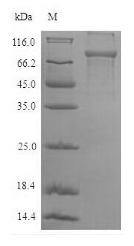E.coli-expressed recombinant Plastin-2 (LCP1) is a full-length of mature protein carrying an N-terminal 6xHis-SUMO-tag. It contains amino acid 2-627 of human LCP1 protein and has a predicted molecular mass of 86.2 kDa. Its purity is up to 90% as determined by SDS-PAGE. This recombinant LCP1 protein may discover uses in the studies of LCP1-related cancers or as an immunogen for antibody synthesis. This protein in-stock is available.
LCP1, a.k.a. leukocyte plastin/L-plastin, is an actin-bundling protein exclusively expressed in hematopoietic and cancer cell lineages. In addition to involvement in both innate immunity and adaptive immunity, LCP1 has been detected significantly up-regulated in many cancer cell lineages and is correlated to cancer invasion and metastasis. LCP1 thus can serve as a common marker of many types of human cancer.






